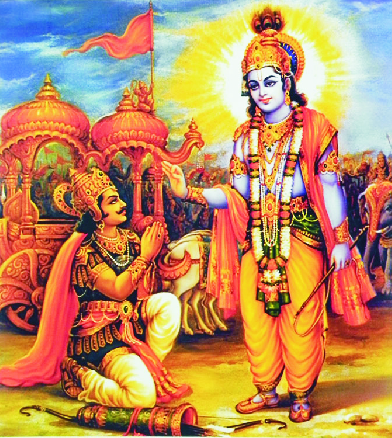By the good fortune of all of us, in the Bharatiya tradition, literature of the Vedas and Upanishads, and the Bhagawad Geeta are like the Kalpavruksha and its sweet fruits; a mutual integral relation!
In other words, the sages have proclaimed,
‘Sarvopanishado Gavo Dogdhaa Gopala nandnah |
Partho Vatash Sudhirbhoktaa Dugham Geetamrutam Mahat ||’
All the Upanishads are cows, Gopala-Nandan, Shri Krishna is the cowherd milking them, and then Partha, i.e. Arjuna, is the calf who is fortunate to drink this nectar.
The meaning is that all the spiritually inclined people have the benefit of this nectar of the precious teachings of the Geeta!
In this context, Gnyaandav also says, in Gnyaneshwari:
‘Taise Geetache He Dubhate | Vatsa Karuni Parthaate |
Dubhjinali Jagaapurate | Shri Krushna Gaaya || (18.1689)
OR
‘Maga Aartaacheni Vorse | Geeta Granthana Mishen |
Varshalaa Shanta Rase | To Haa Granthu ||’ (18.1761)
Generations of people of Bharat have been benefited from this nectar like teachings of the Geeta. Just like the Mahabharat, the Geeta within it is also ever new, spreading the benefit to all those who seek it. Every generation can find new meaning suited to its needs, and also post new thought-challenges as per their environment, and civilizational context. While grasping the meanings of the words, the sentences, and phrases within the shlokas of the Geeta, one has to be conscious of the underlying core of the teachings to derive benefit from this nectar.
Saint Gnyandeva in his ‘Bhavaarth Deepika’, Geeta-Gnyaneshwari commentary, says through Lord Shi Shankara:
‘Ya Geetaarthachi thori |Swayem Shambhu Vivari |
Jeth Bhawani prashnu kari | Chamatkarouni ||
Tetha haru mhane Nenhije |Devi jaise kan swarpooa tuze ||
Teyesen se nityanutana Dekhije | Geetaa tatva ||’
(Adhayaya 1, Verse 70, 71)
(This commentary on the Geeta is by Lord Shiva Himself, in answer to Parvati’s question: “it is amazing, Devi, just like your own beauty, Geeta philosophy is ever new.)
The Geeta’s teaching, the wealth of the ideas contained in it, as well as the guidance it offers in a variety of ways to is ever new. In this context, Vinobaji’s explanation is helpful. In the ‘Geeta Pravachane’, a collection of his talks, he says at the beginning of discussion (pg. 17, 18)
‘In the Geeta, a word is sometimes interpreted in a different way as per the context. To improve upon the meaning of a word by transforming it into a new word is a nonviolent process of bringing about a revolution in ideas. Bhagawan Vyasa is an expert in this field. By giving a word thereby a much wider meaning Geeta has remained ever fresh. Many thinkers, thereby, have been enabled to give a different meaning according to their particular need. All of these meanings can be appropriate in their own place and we also can, without antagonism to them, our own independent interpretation; this is my view’
Therefore we can see that as time went by, many independent interpretations are extent today and in future also will appear. We can observe in this context that Aadi Shankaracharya found pure Adwaita in the Geeta; Ramanujacharya found Vishshtadvaita; Nimbarkacharya, Dwaitaadwaita or Bhedaabheda; and Vallabhacharya saw Vishuddhadwaita (or Pushti Marga) in the Geeta. Again Shridharacharya saw Pure Unism in the Geeta. While Madhavacharya found pure Dwaita in it. This last is well known as “Madhva Mata’ after his name.
This is, then, our ancestral heritage! We also have precious heritage of interpretations in the middle age and in more recent times. We observe that in the same Geeta, Sant Gnyaneshwar discovers Brahmakaran based ‘Chid Vilas’, Play of consciousness or a latter form utility based ‘Bhaktiyoga’. In the same Geeta, Waman Pandit sees Gnyana based Bhaktiyoga. Lokmaanya Tilak saw in the Geeta, Nishkaam Karma Yoga, Yoga of Action without desire for fruits of action. Mahatma Gandhi saw nonviolence based Anasaktiyoga in the Geeta. While Acharya Vinoba Bhave deciphered constructive Saamya Yoga. Age from the same source of Geeta, Sadashive Shastri Bhide has said that ‘Nishkaam Karmayoga’ – working without expectation can lead to National prosperity and Shri Karandikar has clarified the same – as working without attachment.
Another reason for this is that Bhagawad Geeta is an Upanishad and in Upanishads, a phrase can be interpreted in a wider context. This is also the reason why the Geeta philosophy is always and ever new. There is a story in the Upanishads illustrating this point (Geeta Pravachane – P. 18)
On the Devas, Danavas and Men together went to their father, Prajapati Brahma Dev, seeking the benefit of his wisdom. Prajapati told them ‘Da’. Only one syllable ‘Da’!
The Devas, celestial Beings, thought over the same and felt that we are always seeking sensual enjoyment of plenty of riches. They felt that Prajapati has told them to learn by ‘Da’ – Daman, to control their senses. The Danavas, being cruel and short tempered by their nature, felt that Prajapati has told them to be more loving and give up cruelty – Daya. Manavas (mankind), who always wished to amass and enjoy more and more riches, felt that ‘Da’ means ‘Daan’ – Prajapati teaches them to give alms to the needy.
Prajapati told them that all of them were right, because the meaning they understood was according to their need of what they should learn. Thus in the Upanishads, the words and phrases are amenable to wider interpretation of their meanings and always fresh in the context of the changing environment. This is equally true about the interpretations of what the Geeta teaches in each ‘yuga’ – epoch, because Shrimad Bhagawad Geeta is also an Upanishad.
